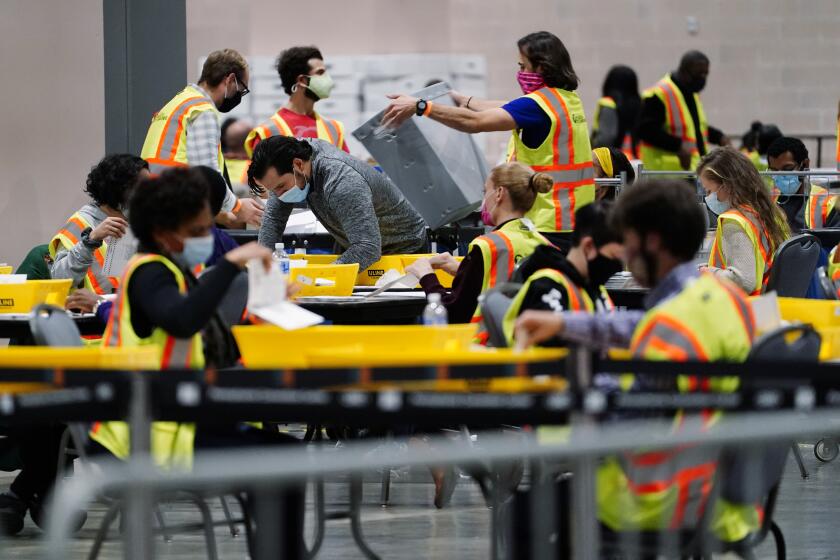Fifty years after the first campus massacre, a question lingers: Who killed the killer?
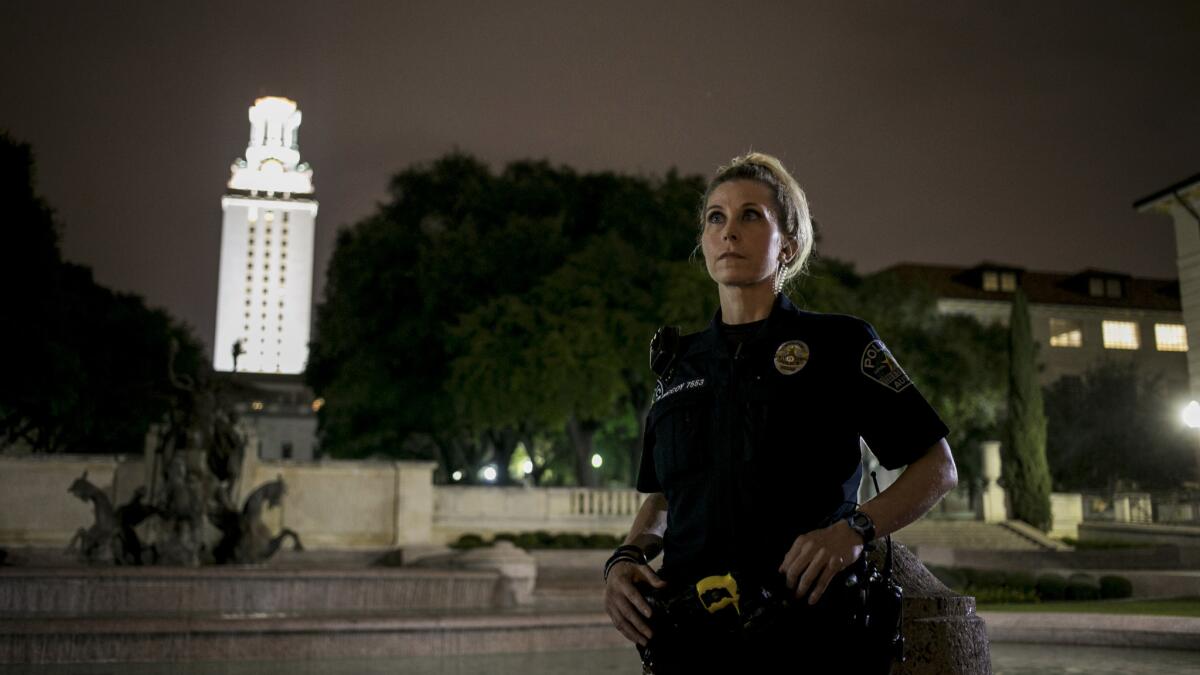
Reporting from AUSTIN, Texas — The entrance to the tower looming over the University of Texas here is inscribed with the Bible verse John 8:32 in massive block letters: “Ye shall know the truth and the truth shall make you free.”
It befits academic life at one of the country’s premier public universities.
But the tower is best known as the perch from which a former Marine sniper carried out what is widely considered the nation’s first mass shooting.
In that sense, the inscription speaks to a different quest for truth: the truth about who killed the killer that August day 50 years ago.
The question still hangs over the man who has long been celebrated as the hero. It hangs over the family of the man who went to his grave believing he deserved more credit.
None of them, it seems, will ever be free.
Long before Columbine, Virginia Tech and Sandy Hook, there was the UT Austin tower.
On Aug. 1, 1966, a clean-cut architecture and engineering student named Charles Whitman wheeled a dolly full of guns and ammunition on to the tower elevator, made his way to the observation deck and began shooting at people 27 stories below.
By the time it ended 96 minutes later, 14 people were dead and more than 30 wounded. Derailed by mental illness, Whitman had started his rampage the day before by killing his mother and his wife.
The death toll would surely have been higher had it not been for two police officers.
Ramiro Martinez was a 29-year-old sergeant and had been on the force for six years. He was off duty when he heard on the noon news that a shooting was in progress, and rushed to the scene with his .38 service revolver.
On the metal stairs leading to the observation deck, he stopped briefly to help a woman who was bleeding badly and struggling to breathe. Then he forced open the door that Whitman had barricaded with his dolly.
As he rounded the tower, he looked back and saw a familiar face: Houston McCoy.
McCoy, a 26-year-old patrolman who had been on the force three years, had been working his beat near campus when a dispatcher called him to the scene. Carrying a shotgun, he had entered the tower through a maintenance tunnel and made his way to the top.
When the two men rounded the corner together, Whitman came into view. Both officers fired their weapons.
The next thing that is known for sure is that Martinez left the tower first, yelling, “I got him!”
At a news conference the next day, Police Chief Robert Miles credited Martinez with shooting Whitman, calling him “the hero of the day.”
“I had a job to do and that’s what I was going out there to do,” Martinez told reporters as camera flashbulbs went off around him.
In 2006, the city designated Aug. 1 “Ramiro Martinez Day.” The county later named a building for him. At the Texas Ranger Hall of Fame & Museum in Waco, a display case features his revolver.
Austin needed a hero, and Martinez embraced the role.
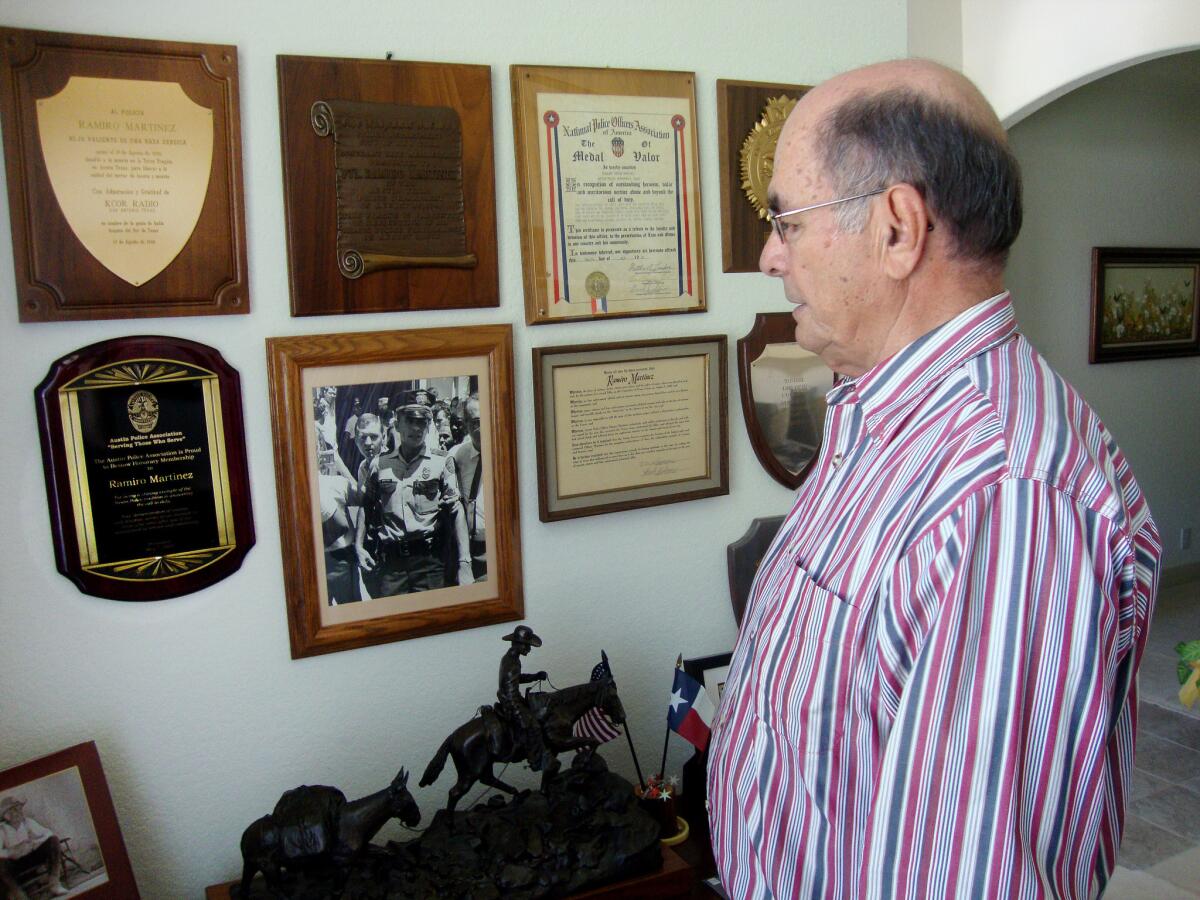
In his home office in New Braunfels, an hour’s drive south of Austin, 79-year-old Martinez pored over the old newspaper clippings, the transcripts of the emergency calls, the autopsy report of the shooter.
He pointed to a grainy photograph of himself, taken minutes after the killing ended, his uniform stained with the blood of victims he helped.
It’s all there — all the evidence of the day that came to define his entire life.
“The reason I got the publicity a lot of the time was I was willing to speak to the media,” Martinez said. “I felt like this was therapy for me, not to keep it bottled up.”
In his telling, he unloaded his six-shot revolver — hitting Whitman before McCoy got him with his shotgun — then grabbed the shotgun and fired a final shot as the sniper was still moving.
That was the story that stuck.
Martinez went on to have a long career as a Texas Ranger. Retired now, balding and trim, he still has a trooper’s stiff posture.
Pacing his office in black ostrich Texas Ranger boots, Martinez pointed out awards for bravery covering one wall and bristled at the suggestion that McCoy’s shots may have hit Whitman first.
“I knew what I was hitting,” he said, carrying a file into the dining room and spreading it on the table as his wife, VerNell, stood nearby. “When I look at the autopsy report I can see where I was hitting him.”
Then, for a moment, he seemed willing to allow that maybe the truth is more complicated.
“Now, I’m not going to stand here and say I fired the fatal shot,” he said. “I don’t care who fired the fatal projectiles. I just care that the job was done.”
His wife has heard it all many times. “It doesn’t matter which bullets killed him,” she said. “Why make such a big deal about it?”
But Martinez can’t let it go.
“Time doesn’t go by that I don’t wake up at night and it’s still going,” he said. “The tower is there. Fifty years and it’s still going.”
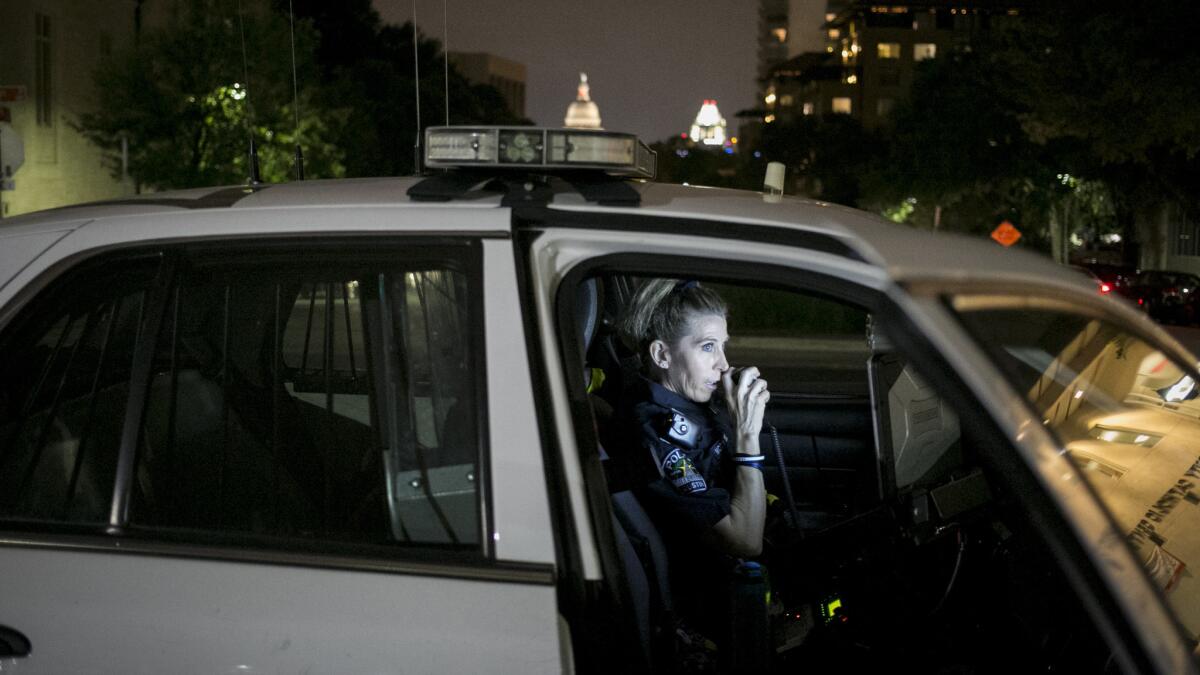
Monika McCoy cannot escape it either.
By the time she was born — five years after the tower shooting — her father had already left the police force for a better-paying job as a civilian flight instructor with the Air Force and moved his growing family back to his native West Texas.
The youngest of his four children, Monika McCoy grew up on 300 acres along the San Saba River, 170 miles west of Austin. Her parents were always taking in strangers passing through.
Her father hunted for arrowheads, barbecued goat, made his own venison jerky and sausage — and spoke little about the tower shooting.
“A discerning person will know the truth,” he used to say. Old photographs of him in his police uniform fired his daughter’s imagination. He looked stoic, she thought.
The shootings clearly remained on his mind. He took refuge in Winston cigarettes and Lone Star beer.
It was the designation of “Ramiro Martinez Day” in 2006 that finally persuaded Houston McCoy to tell his side of the story. By then he was in a nursing home with lung disease.
His daughter helped him research the shooting and post his account online. It took them five years.
According to the account, Martinez quickly emptied his revolver before McCoy aimed his shotgun at Whitman’s white headband and pulled the trigger.
“As the first shot would prove to be instantly fatal, I saw him alive for only a split second before he was dead and of no more danger,” he wrote.
At that point, he said, Martinez “jerked the shotgun from my hands, and while yelling, ran to the motionless body and fired point blank.”
“Martinez then forcefully threw my shotgun onto the floor, began jumping up and down and waving his arms, and repeatedly hollered, ‘I got him!’”
McCoy died within a month after publishing his account. He was 72.
His daughter, who has continued to dedicate herself “to setting the record straight” about her father’s role in stopping the carnage, said the hero-status that Martinez achieved would not have bothered her if her father and others who helped that day were also honored.
“It would have never mattered if it was portrayed as a team effort,” she said.
She has carried on his legacy in another way as well. Three years ago, she became an officer with the Austin police force.
Now 45, she works her father’s old beat in the shadow of the tower.
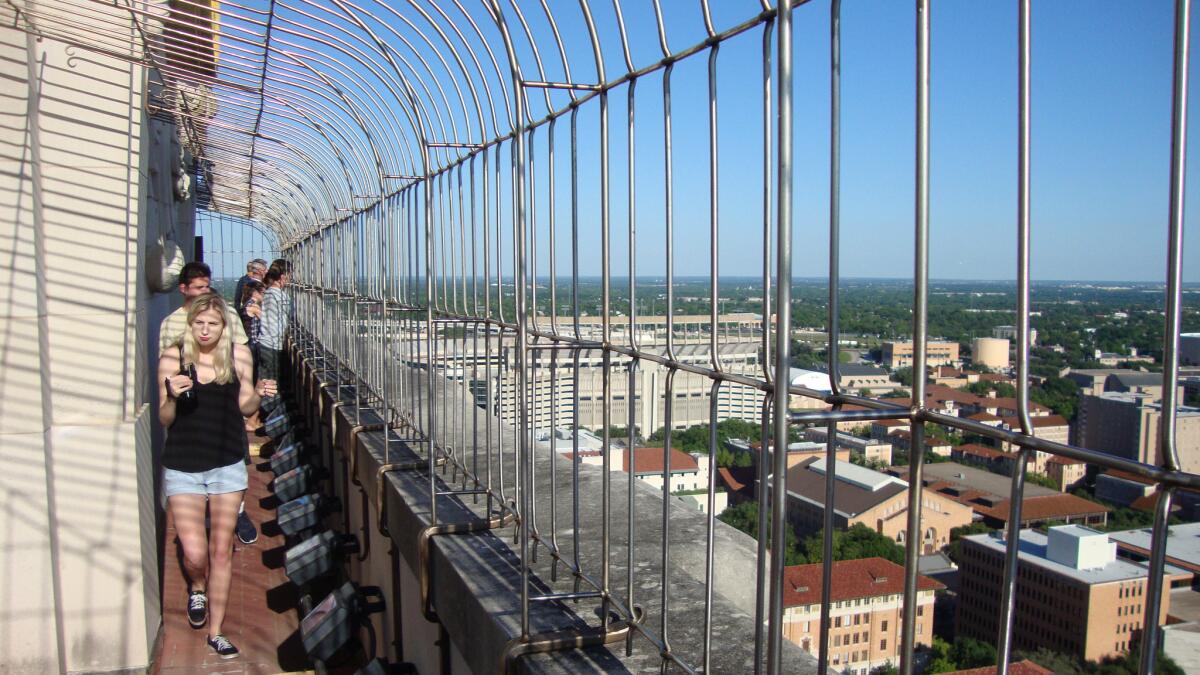
On Aug. 1, the 50th anniversary of the shooting, a new Texas law is set to go into effect expanding gun rights on college campuses.
The tower has loomed in the background of bitter debate over the law, which with few exceptions requires public schools to honor state-issued concealed weapons permits.
Some gun rights advocates testified in hearings with state lawmakers that armed citizens improve public safety.
But opponents argued that the new law would increase the likelihood of accidental or mass shootings.
In an interview, Martinez called the new law “stupid” and unlikely to deter crime. “It’s opening up a Pandora’s box,” he said.
During the tower shooting, some armed citizens on the ground shot at Whitman. That restricted his movement, Martinez said, but also put him and McCoy in danger.
Monika McCoy said that since she’s a police officer, she can’t comment on the politically charged law.
As for mass shootings, she has yet to respond to one. But she keeps track of them — 89 so far this year across the country — and has the same reaction each time.
Most people read the news and move on with their lives. But she thinks about the effect it will have across generations.
ALSO
Surfing icon Laird Hamilton shares his 10-point plan to live forever
EgyptAir crash raises new questions about European airport security
Afghanistan’s intelligence agency confirms Taliban leader killed in U.S. airstrike
More to Read
Sign up for Essential California
The most important California stories and recommendations in your inbox every morning.
You may occasionally receive promotional content from the Los Angeles Times.










